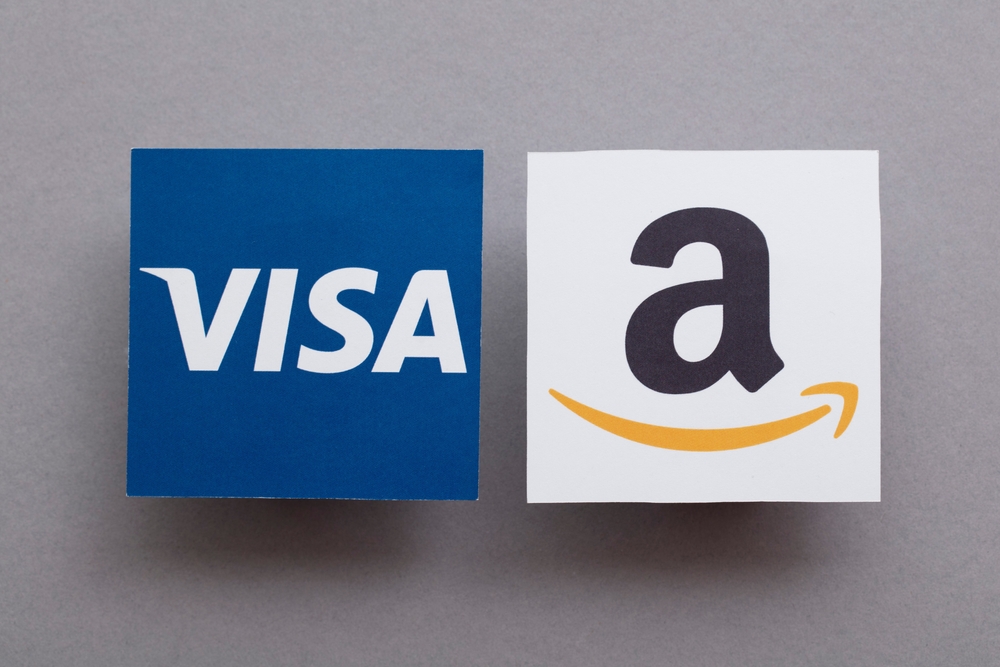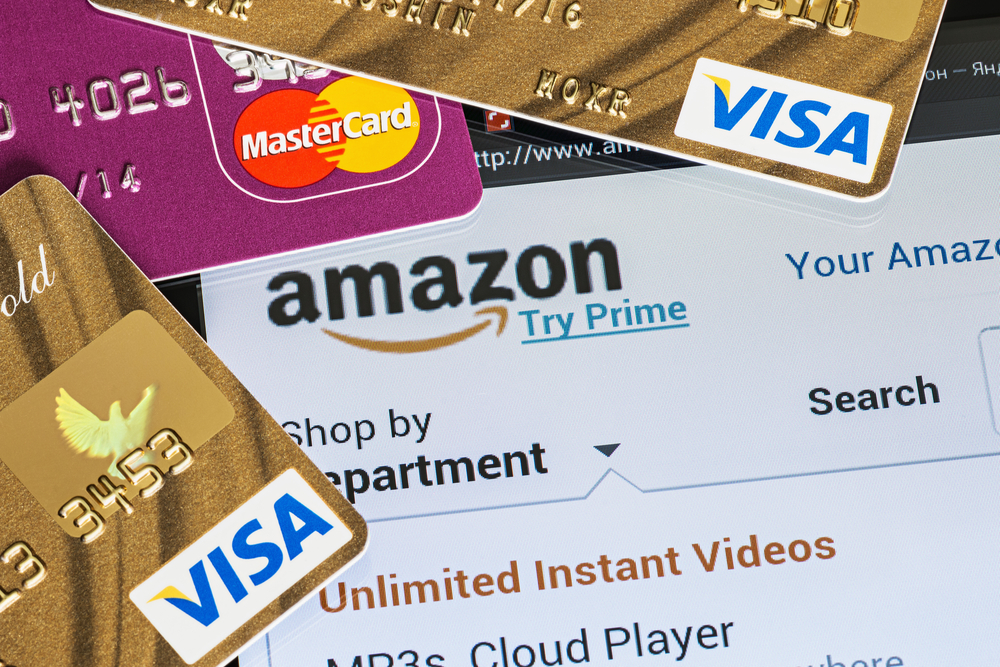Why Amazon Held Off Ban On UK Visa

Amazon planned to ban UK payments processed by Visa credit cards. The threat from the global online retailer followed Visa’s announcement to increase payment fees on debit and credit cards. Both sides seemingly resolved their differences during talks earlier this month but experts warn the truce is temporary.
The latest in the bitter feud
- Visa and their rival Mastercard announced increased fees early last year
- Adjusted rates came into effect October 2021
- Amazon responded in November, emailing customers to switch payment method from Visa credit cards
- The ban set for 19th January 2022 is lifted following negotiations earlier this month
So, after all the posturing and war of words, why has Amazon made a complete one-eighty? Why is Mastercard exempt from a ban if they raised their fees too? What even are these fees? Most importantly, how does this affect you?
What are these payment fees?
When a customer purchases something online, four parties are involved in the transaction of funds. The customer is on one end, the merchant on the other, and between them are the customer’s and retailer’s banks.
The retailer sends details about the requested transaction to their bank; known as the acquiring bank. This information is then relayed to the customer’s bank; the card issuer. When the card issuer authorises the payment, it retains a small amount of the total cost. This small amount is called the interchange fee and is the focal point of the dispute between Amazon and Visa.
However, Visa claims they do not take any amount of interchange fees. Banks invest the collected money into security, better customer support and technological innovations such as different payment methods.
If Visa makes no money from interchange fees, why does Amazon want to ban them?
Even though interchange fees are paid out to banks, card network companies like Visa set the rates. Hence the reason why they’ve earned Amazon’s ire. It’s not so much that Visa is making money which upsets Amazon so much. It’s about power between the world’s biggest retailer and a card network company with 52% of the global market share.
Visa dominates the UK. In 2019 it reportedly accounted for 82% of domestic card schemes. Compare that to Mastercard, which had only a 17% hold of the UK’s market.
Why did Amazon exempt Mastercard from its threats?
Last year, Mastercard announced plans to adjust interchange fees between UK online customers and merchants in the European Economic Area. Interchange fees for online transactions made with debit cards rose from 0.20% to 1.15%. Credit card fees went from 0.30% to 1.50%.
Similarly, Visa raised interchange fees also in accordance with interregional capped rates. Meaning their figures are exactly the same as Mastercard. So, why did Mastercard get a free pass?
1) A difference in who the adjusted rates are applicable to.
2) Mastercard has strong business ties with Amazon, the pair offering a co-branded credit card to customers.
Mastercard’s interchange fees only apply to online purchases made between UK issued cards and EEA-merchant locations. Whereas Visa applies a bilateral interchange fee for transactions between the UK and EEA. Sellers in the UK and Europe who use Visa will see a slight reduction in profits due to increased interchange fees.
Why payment fees were increased
Banks take on risks when they issue credit cards. Therefore, interchange fees also act as compensation, as they allow banks to recuperate losses from bad borrowers. It’s in Visa’s interest to incentivise banks to stay with them.
If you’re a customer of RBS, Barclays or Santander, you’ll see Visa’s logo on your card. This is because Visa provides financial services to those banks and building societies. Whereas NatWest switched over from Visa to Mastercard.
The five-fold increase in interchange fees made by Mastercard and Visa are attributed to Brexit. It’s clear to see the correlation. But what’s the reason for the different approaches taken by both parties in the Visa-Mastercard duopoly?
It seems Mastercard is trying to appeal to UK-based sellers. Perhaps in an effort to chip away at Visa’s significant market share. Whereas Visa’s bilateral model offers no incentive for UK or EEA merchants to switch.
How do increased interchange fees affect Amazon?
If anything, it affects sellers as many may need to increase prices on their products. Obviously, this can turn potential customers away. UK merchants will see increased deductions from their profits. Unless of course, they switch to Mastercard. This is clearly Amazon’s agenda here. A claim that can be substantiated by Amazon’s pushback.
In an aggressive Amazon promotion, non-Prime customers who switched from Visa to Mastercard received £10 free credit. Prime customers got £20.00.
A survey of 2,000 adults in the UK revealed some interesting insights. A third planned to register another card in order to use Amazon after the ban transpired. There are 48 million Amazon customers in the UK. If a third of those switched from Visa, they’ve lost 16 million cards in circulation.
So, why did Amazon lift the ban?
The same poll indicated some worrying signals for Amazon. Namely, that they’d lose up to £1.4bn from UK shoppers. One-third of those surveyed also claimed they felt negative about Amazon’s solution to Visa’s interchange fees. The inconvenience of registering another card was a major concern for most surveyed Brits. Only 11% of whom felt positive about the change at all.
How does this affect you?
Spokespeople from both sides remain tight-lipped. There’s no knowing what the future holds for Amazon customers who use Visa credit cards. Until we see statistics for how many people switched, we can only guess what Amazon will do next. Visa may yet lower their interchange fees or copy Mastercard’s unilateral model.
So, what do we advise our customers to do who are subscribed to Amazon Prime? Kick back, stream your favourite shows, safe in the knowledge that our broadband can easily deliver 5Mbps for HD viewing.
In the meantime, we’ll keep a lookout for the latest. Any updates or what we think you should do will be posted here in our blog or guide. Until then, catch up on some of these Christmas goodies.
Amazon planned to ban UK payments processed by Visa credit cards. The threat from the global online retailer followed Visa’s announcement to increase payment fees on debit and credit cards. Both sides seemingly resolved their differences during talks earlier this month but experts warn the truce is temporary.
The latest in the bitter feud
- Visa and their rival Mastercard announced increased fees early last year
- Adjusted rates came into effect October 2021
- Amazon responded in November, emailing customers to switch payment method from Visa credit cards
- The ban set for 19th January 2022 lifted following negotiations earlier this month
So, after all the posturing and war of words, why has Amazon made a complete one-eighty? Why is Mastercard exempt from a ban if they raised their fees too? What even are these fees? Most importantly, how does this affect you?
What are these payment fees?
When a customer purchases something online, four parties are involved in the transaction of funds. The customer is on one end, the merchant on the other, and between them are the customer’s and retailer’s banks.
The retailer sends details about the requested transaction to their bank; known as the acquiring bank. This information is then relayed to the customer’s bank; the card issuer. When the card issuer authorises the payment, it retains a small amount of the total cost. This small amount is called the interchange fee and is the focal point of the dispute between Amazon and Visa.
However, Visa claims they do not take any amount of interchange fees. Banks invest the collected money into security, better customer support and technological innovations such as different payment methods.
If Visa makes no money from interchange fees, why does Amazon want to ban them?
Even though interchange fees are paid out to banks, card network companies like Visa set the rates. Hence the reason why they’ve earned Amazon’s ire. It’s not so much that Visa is making money which upsets Amazon so much. It’s about power between the world’s biggest retailer and a card network company with 52% of the global market share.
Visa dominates the UK. In 2019 it reportedly accounted for 82% of domestic card schemes. Compare that to Mastercard, which had only a 17% hold of the UK’s market.
Why did Amazon exempt Mastercard from its threats?

Last year, Mastercard announced plans to adjust interchange fees between UK online customers and merchants in the European Economic Area. Interchange fees for online transactions made with debit cards rose from 0.20% to 1.15%. Credit card fees went from 0.30% to 1.50%.
Similarly, Visa raised interchange fees also in accordance with interregional capped rates. Meaning their figures are exactly the same as Mastercard. So, why did Mastercard get a free pass?
1) A difference in who the adjusted rates are applicable to.
2) Mastercard has strong business ties with Amazon, the pair offering a co-branded credit card to customers.
Mastercard’s interchange fees only apply to online purchases made between UK issued cards and EEA-merchant locations. Whereas Visa applies a bilateral interchange fee for transactions between the UK and EEA. Sellers in the UK and Europe who use Visa will see a slight reduction in profits due to increased interchange fees.
Why payment fees increased
Banks take on risks when they issue credit cards. Therefore, interchange fees also act as compensation, as they allow banks to recuperate losses from bad borrowers. It’s in Visa’s interest to incentivise banks to stay with them.
If you’re a customer of RBS, Barclays or Santander, you’ll see Visa’s logo on your card. This is because Visa provides financial services to those banks and building societies. Whereas NatWest switched over from Visa to Mastercard.
The five-fold increase in interchange fees made by Mastercard and Visa are attributed to Brexit. It’s clear to see the correlation. But what’s the reason for the different approaches taken by both parties in the Visa-Mastercard duopoly?
It seems Mastercard is trying to appeal to UK-based sellers. Perhaps in an effort to chip away at Visa’s significant market share. Whereas Visa’s bilateral model offers no incentive for UK or EEA merchants to switch.
How do increased interchange fees affect Amazon?
If anything, it affects sellers as many may need to increase prices on their products. Obviously, this can turn potential customers away. UK merchants will see increased deductions from their profits. Unless of course, they switch to Mastercard. This is clearly Amazon’s agenda here. A claim that can be substantiated by Amazon’s pushback.
In an aggressive Amazon promotion, non-Prime customers who switched from Visa to Mastercard received £10 free credit. Prime customers got £20.00.
A survey of 2,000 adults in the UK revealed some interesting insights. A third planned to register another card in order to use Amazon after the ban transpired. There are 48 million Amazon customers in the UK. If a third of those switched from Visa, they’ve lost 16 million cards in circulation.
So, why did Amazon lift the ban?
The same poll indicated some worrying signals for Amazon. Namely, that they’d lose up to £1.4bn from UK shoppers. One-third of those surveyed also claimed they felt negative about Amazon’s solution to Visa’s interchange fees. The inconvenience of registering another card was a major concern for most surveyed Brits. Only 11% of whom felt positive about the change at all.
How does this affect you?
Spokespeople from both sides remain tight-lipped. There’s no knowing what the future holds for Amazon customers who use Visa credit cards. Until we see statistics for how many people switched, we can only guess what Amazon will do next. Visa may yet lower their interchange fees or copy Mastercard’s unilateral model.
So, what do we advise our customers to do who are subscribed to Amazon Prime? Kick back, stream your favourite shows, safe in the knowledge that our broadband can easily deliver 5Mbps for HD viewing.
In the meantime, we’ll keep a lookout for the latest. Any updates or what we think you should do will be posted here in our blog or guide. Until then, catch up on some of these Christmas goodies.


